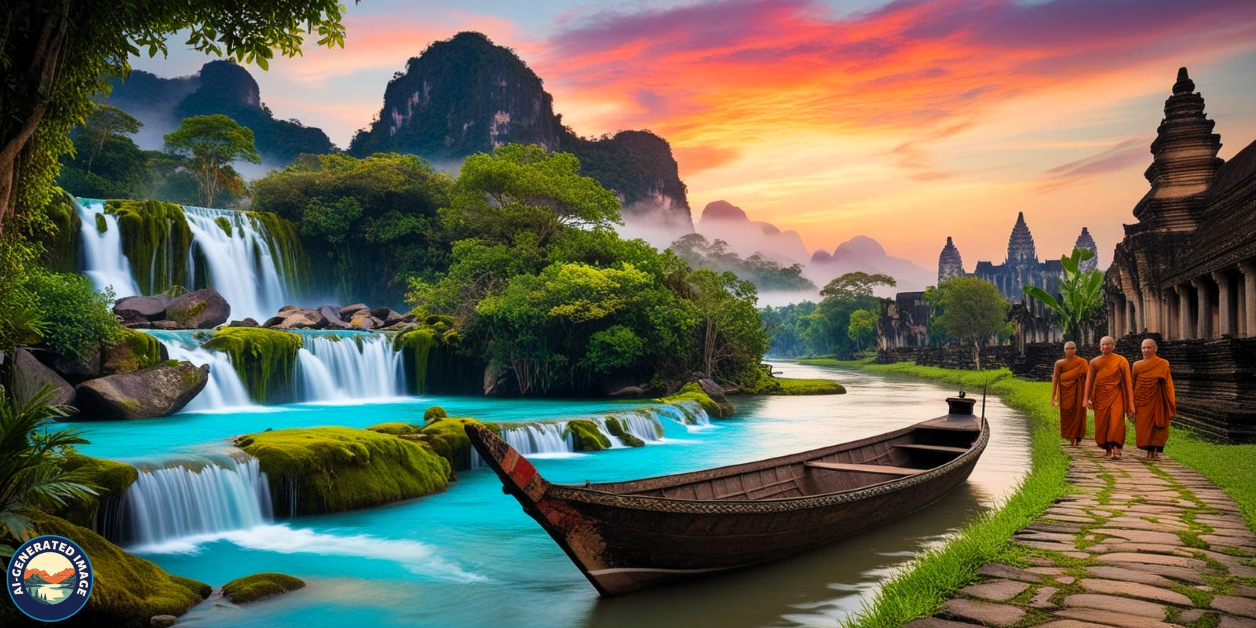Introduction
Laos, a hidden Southeast Asian treasure, offers a unique blend of breathtaking landscapes, rich traditions, and a peaceful atmosphere. Unlike its more tourist-heavy neighbors, Laos provides an authentic travel experience for those seeking adventure, history, and cultural immersion.

In this guide, we will explore Laos’s historical and cultural essence, highlight its must-visit destinations, and provide essential travel tips to help you make the most of your journey.
History and Culture
Laos, officially the Lao People’s Democratic Republic, boasts a history that dates back centuries. Once part of the mighty Lan Xang Kingdom, known as the “Land of a Million Elephants,” it thrived from the 14th to 18th centuries. This era significantly shaped the country’s cultural and religious traditions.
Buddhism is deeply ingrained in Laotian society, influencing architecture, daily rituals, and festivals. Ornate temples, such as Wat Xieng Thong in Luang Prabang, reflect the country’s devotion. Annual celebrations, including Pi Mai Lao (Lao New Year) and That Luang Festival, are marked by traditional performances, vibrant processions, and local delicacies.
A remarkable tradition is the morning alms-giving ceremony in Luang Prabang, where monks collect food offerings, fostering a spiritual connection between the people and their faith.
Must-Visit Destinations
Luang Prabang – A UNESCO Heritage Gem
Luang Prabang is renowned for its well-preserved colonial architecture, stunning waterfalls, and vibrant markets. Key attractions include:
-
Wat Xieng Thong –
- An exquisite Buddhist temple with intricate golden artwork.

-
Kuang Si Falls –
- A series of stunning turquoise waterfalls perfect for swimming.

-
Mount Phousi –
- A scenic viewpoint offering panoramic sunset views.

-
Night Market –
- A hub for Laotian handicrafts and street food delights.
Vientiane – The Tranquil Capital
Vientiane’s capital city is a harmonious mix of colonial structures, Buddhist temples, and riverside charm. Highlights include:
-
Pha That Luang –
- Laos’ most sacred monument represents Buddhist values.

-
Patuxai (Victory Gate) –
- A war memorial reminiscent of the Arc de Triomphe, yet adorned with Lao motifs.

-
Buddha Park –
- A unique collection of over 200 Buddhist and Hindu statues.

Vang Vieng – A Nature and Adventure Haven
Surrounded by karst mountains and lush landscapes, Vang Vieng is an adventure-lover’s paradise. Activities include:
-
Tubing on the Nam Song River –
- A fun way to enjoy scenic beauty.
-
Hot Air Balloon Rides –
- A breathtaking aerial experience.
-
Cave Exploration –
- Visit Tham Chang and Tham Nam caves for a glimpse into Laos’s underground wonders.
Plain of Jars – An Archaeological Mystery
Located in Xieng Khouang Province, this mysterious site features thousands of ancient stone jars scattered across the landscape. While the exact origins remain uncertain, theories suggest they were used for burial or storage.
Si Phan Don (4,000 Islands) – A Tranquil Riverside Escape

Nestled in the Mekong River, Si Phan Don offers a peaceful retreat with stunning natural beauty. Visitors can:
-
Spot Rare Irrawaddy Dolphins –
- It’s best seen near Don Khon Island.
-
Cycle Through Serene Villages –
- Explore the local lifestyle and breathtaking views.
-
Visit Khone Phapheng Falls –
- Southeast Asia’s largest waterfall.

Bolaven Plateau – Coffee, Waterfalls, and Ethnic Culture
This highland region is perfect for nature lovers and coffee enthusiasts. Must-do activities include:
-
Touring Coffee Farms –
- Discover the process behind Laos’s famous coffee.
-
Exploring Waterfalls –
- Visit the majestic Tad Fane and Tad Yuang waterfalls.
-
Visiting Ethnic Villages –
- Experience the rich traditions of indigenous communities like the Laven and Alak people.
Unique Experiences
-
Participate in the Alms-Giving Ceremony –
- Witness the spiritual practice of monks collecting morning offerings.
-
Cruise the Mekong River –
- A scenic journey from Huay Xai to Luang Prabang.
-
Savor Laotian Cuisine –
- Try authentic dishes like laap (minced meat salad), sticky rice, and tam mak hoong (spicy papaya salad).
-
Explore Traditional Villages –
- Engage with diverse ethnic groups such as the Hmong and Khmu.
Outdoor Adventures
-
Trekking in Luang Namtha –
- Discover remote trails and ethnic villages.
-
Rock Climbing in Vang Vieng –
- Scale dramatic limestone cliffs.
-
Kayaking on the Nam Ou River –
- Paddle through scenic waterways.
-
Cycling in Champasak –
- Explore ancient ruins and rural landscapes.
Essential Travel Tips
-
Best Time to Visit:
- November to April (dry season) for ideal weather.
-
Visa Requirements:
- Most travelers can obtain a visa on arrival or apply for an eVisa.
-
Currency:
Lao Kip (LAK), though USD and Thai Baht are commonly accepted.
-
Local Etiquette:
- Dress modestly in temples, remove shoes before entering homes, and show respect to elders.
-
Transportation:
- Tuk-tuks, buses, and boats are common; renting a motorbike is a great option for exploring remote areas.
Conclusion
Laos offers an unparalleled mix of history, culture, and adventure. From the charming town of Luang Prabang to the breathtaking waterfalls of the Bolaven Plateau, every corner of this country provides a unique and unforgettable experience. Laos remains a place where travelers can slow down, immerse themselves in nature, and engage with warm-hearted locals.
If you’re looking for an authentic and off-the-beaten-path destination in Southeast Asia, Laos should be at the top of your list!
FAQs
Is Laos expensive to visit?
No, Laos is one of the most budget-friendly destinations in Southeast Asia, with affordable accommodations, food, and transport options.
How many days are ideal for exploring Laos?
A week is enough to see the highlights, but two weeks allow for deeper exploration.
What language is spoken in Laos?
Lao is the official language, but English is widely spoken in tourist areas.
Is Laos safe for tourists?
Yes, Laos is generally very safe, though visitors should be mindful of petty theft and unexploded ordnance (UXO) areas.
What should I pack for a trip to Laos?
Lightweight clothing, a rain jacket, mosquito repellent, sunscreen, and respectful attire for temple visits.
